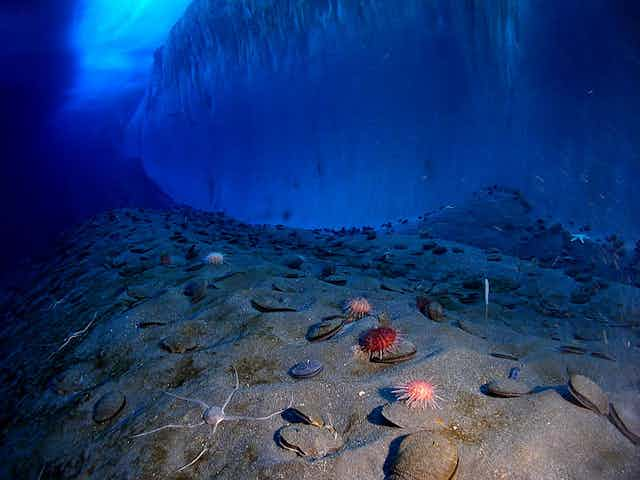When it comes to climate change, temperature is only part of the story. Climate gases released by human activity are dissolving into the oceans, and the increased levels of CO₂ are making the waters more acid. This process threatens marine life from coral reefs to fragile polar ecosystems. It seems likely that the polar oceans will be the first to feel the full force of ocean acidification. These cold seas may provide an important lesson for Australia’s warmer waters.
Heading for the poles
Changes in the earth’s climate are expected to have major effects on marine biodiversity. Predicting how species will respond to shifts in the timing, magnitude and predictability of future climate patterns is one of the key issues for humanity over the next 100 years.
There are a number of ways marine species can persist in the face of these changes. They can cope within their current physiological capacity, migrate to new regions, or adapt to new conditions. Otherwise they risk becoming extinct.
The ranges of oceanic species worldwide are shifting polewards towards cooler latitudes, and as these places warm faster, marine life is moving faster too. But the effect of acidification on marine animals is expected to add to the impact of temperature.
Hard-shelled but thin-skinned
Ocean acidification makes it harder for marine animals to build their calcium carbonate skeletons, which they need for movement and protection against predators.
As oceans become more acid, seawater chemistry is altered, making calcium carbonate harder to extract and increasing the cost of producing shells. More gas dissolves in cold water and therefore animals from colder oceans are at greater risk from acidification from atmospheric increase in CO₂. Calcium carbonate saturation is already lower in polar oceans, and as oceans acidify, undersaturation is predicted to occur first in the shallow waters around Antarctica.
Ocean acidification will, therefore, result in calcium carbonate becoming a limiting resource for animals at the poles, before it becomes a limit in oceans closer to the tropics. The poles are “natural laboratories” for investigating the impact of ocean acidification, particularly when compared to lower latitudes.
A recent study has shown that the proportion of body mass given to shell production is less in colder oceans, where concentrations of available calcium (Ca2+) are reduced.
Building a skeleton requires calcium (Ca2+) ions to be pumped, from seawater, against concentration gradients. The larger the gradient - like in the polar oceans - the more energy is required. If the energy costs to the animal increase sufficiently, it may reduce the amount of energy for other functions. For example, if there is less energy for reproduction this would reduce the capacity of the species to sustain its populations.
Stress, from environmental challenge, very often reduces the immune capacity of animals, so they may become more susceptible to disease. Bacteria also multiply faster in warmer conditions.
Changing ecosystems
In the Antarctic, the warming of shallow seas could also see a return of crushing predators such as crabs, which cannot currently survive in such cold water. Shells in polar regions may be too thin to resist these new predators. This will be worse if shells are further thinned as oceans become depleted of available calcium.
This is an extreme example of how shifts in ecological balance are caused by climate change. More subtle ecological shifts in the balance of competition between species, including shifts in energy budgets and disease resistance, are likely to be seen wherever species ranges shift.
As species ranges shift across latitudes they encounter different day lengths at different times. This could drastically effect the timing (the “phenology”) of seasonal activities such as reproduction, causing mismatches with food availability if young hatch at the wrong time.
What can we learn from Antarctica?
The ability of species to cope with all these potential effects of future ocean conditions needs to be assessed. To date we have far too little information to make robust predictions.
How species ranges and abundance will change under future conditions is a vitally important area of study for biologists. We need to be able to predict the effects on both natural ecosystems and the “ecosystem services” these provide to human populations.
Understanding the underlying mechanisms of how species respond to current conditions is similarly important to understand how they will cope with future change. Comparing polar oceans and warmer zones will help interpret the effects that are being seen in the seas around Australia.

